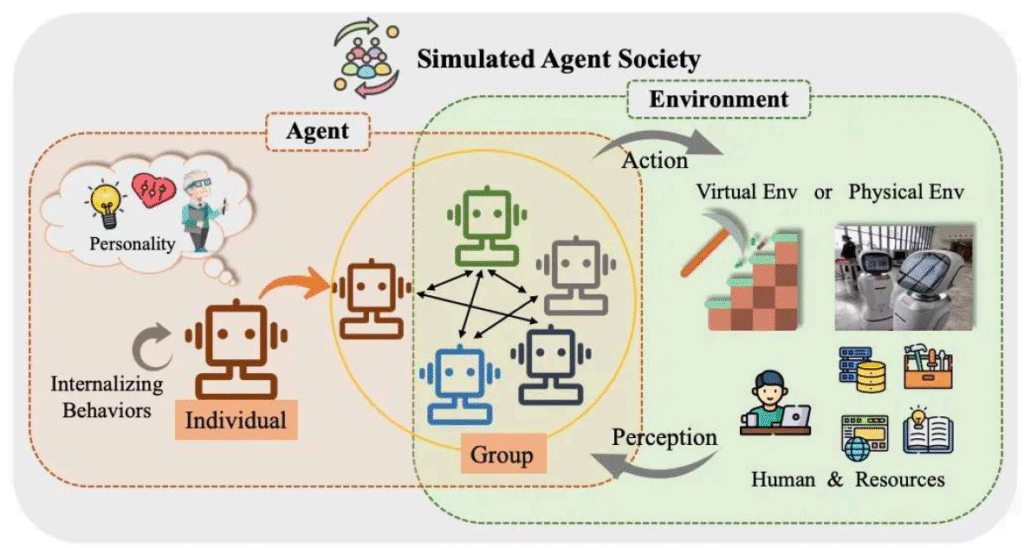In this guide, we will explore AI Agents, covering their definition, how they work, types, roles, real-world examples, and future prospects.
1. What are AI Agents?
An AI Agent is a specialized software system designed to perceive its environment, analyze information, and autonomously or semi-autonomously perform actions to achieve defined goals.
Unlike general AI technologies, AI Agents are proactive entities that sense inputs, reason about them, and decide on appropriate actions to fulfill tasks.
An AI agent typically consists of three core components:
- Perception — The agent’s ability to sense and gather data from its environment using various input channels such as cameras, microphones, sensors, or digital data streams.
- Brain (Reasoning/Processing/Planning) — The central decision-making unit where the agent processes the perceived information, interprets it using algorithms like machine learning or logic, and plans the next steps.
- Action — The execution phase where the agent interacts with the environment or user by performing tasks, sending responses, or controlling devices based on its reasoning.
Together, these components form a continuous loop: perception feeds data to the brain, which processes and decides, leading to actions that may affect the environment and generate new data to perceive.

This cyclical process enables AI Agents to continuously adapt and interact intelligently with their surroundings, often without direct human intervention.
2. The Role and Value of AI Agents
AI Agents serve as intelligent intermediaries that automate and enhance decision-making processes across many domains. Their value lies in:
- Autonomous Task Execution: AI Agents can independently complete complex or repetitive activities without constant human oversight.
- Real-Time Decision Making: By analyzing live data, AI Agents provide timely and accurate actions or recommendations.
- Personalized Interaction: AI Agents tailor their responses or behaviors based on user preferences, context, and historical data.
- Increased Efficiency and Productivity: Offloading routine or data-heavy tasks to AI Agents allows humans to focus on creativity and strategic thinking.
In business and daily life, AI Agents improve workflows, customer experiences, and operational consistency, acting as “digital assistants” or “autonomous problem solvers.”
LLM-Driven AI Agents are AI agents powered by Large Language Models (LLMs) like GPT, which enable them to understand, generate, and interact with human language at an advanced level. These agents combine the core AI agent framework—perception, reasoning (brain), and action—with the language comprehension and generation capabilities of LLMs.
Key Features:
- Natural Language Understanding: LLMs enable AI Agents to interpret complex instructions, queries, and contextual information from natural language inputs.
- Contextual Reasoning: Using vast training data, LLMs provide nuanced reasoning and decision-making based on conversational context.
- Dynamic Interaction: LLM-Driven AI Agents can engage in fluid dialogues, generate creative content, summarize information, or automate tasks involving language.
- Multimodal Capabilities: When combined with other perception modules (e.g., vision, sensors), these agents can handle diverse input types for more holistic understanding and responses.

3. Types of AI Agents in Real-World Applications
AI Agents have become integral in many real-world systems where autonomous sensing, reasoning, and acting are required:
- Reactive Agents
These agents respond directly to environmental inputs without storing past information or learning. They follow pre-defined rules or policies to act immediately.
Example: Basic robotic vacuum cleaners that sense obstacles and change direction instantly. - Model-Based Agents
These AI Agents maintain an internal model of the environment to make informed decisions, using stored knowledge or past experiences to handle complex tasks.
Example: Autonomous vehicles that build maps and track objects to navigate safely. - Goal-Based Agents
Goal-based agents make decisions by evaluating possible actions to achieve specific goals or objectives. They plan sequences of actions rather than reacting instantly.
Example: AI game characters planning moves to win a game. - Utility-Based Agents
These agents choose actions based on a utility function that measures the desirability of outcomes, balancing different factors to optimize overall “happiness” or performance.
Example: Smart thermostats that optimize energy use while maintaining comfort. - Learning Agents
Learning agents improve their performance over time by learning from experience, adapting to changing environments or user preferences.
Example: Recommendation systems like Netflix or Amazon that learn user tastes.
| AI Agent Type | Real-World Example | Description |
|---|---|---|
| Reactive Agent | Simple chatbots, robotic vacuum cleaners | Immediate response to inputs without memory |
| Model-Based Agent | Self-driving cars, drone navigation | Maintains environmental model for decisions |
| Goal-Based Agent | Virtual game players, path planners | Plans actions to achieve specific goals |
| Utility-Based Agent | Smart home systems, financial trading bots | Optimizes actions based on utility or preferences |
| Learning Agent | Personalized recommendation systems | Learns and adapts from user behavior or data |
These examples highlight how AI Agents operate continuously in dynamic environments, making autonomous decisions that benefit users and organizations.
4. Top 10 AI Agent Development Frameworks in 2025
Building intelligent AI agents requires powerful frameworks that simplify integration with large language models, reasoning capabilities, memory management, and multi-agent coordination. Below are the leading AI agent frameworks shaping the AI landscape in 2025.
1). LangChain
Official Site: https://langchain.com
Introduction: LangChain is the most popular framework for developing AI agents powered by large language models (LLMs). It enables chaining multiple LLM calls, managing conversation memory, and integrating external data sources and APIs.
Key Features: LLM chaining, memory management, API/tool integrations, multi-step reasoning
Applications: Conversational AI, document analysis, task automation
2). AutoGPT
Official Site: https://github.com/Significant-Gravitas/Auto-GPT
Introduction: AutoGPT is an autonomous AI agent framework that lets agents set goals, self-direct tasks, interact with web APIs, and continuously improve through feedback loops.
Key Features: Autonomous task planning, recursive goal decomposition, API and web browsing
Applications: Personal AI assistants, autonomous workflows, research automation
3). Microsoft AutoGen
Official Site: https://github.com/microsoft/autogen
Introduction: AutoGen enables scalable multi-agent systems with asynchronous communication and easy debugging, designed for complex AI workflows involving multiple interacting agents.
Key Features: Multi-agent messaging, task coordination, scalability, monitoring tools
Applications: Distributed AI systems, collaborative agent networks
4). Botpress
Official Site: https://botpress.com
Introduction: Botpress is a leading open-source conversational AI platform focused on creating advanced chatbots with natural language understanding and multi-channel deployment.
Key Features: Visual flow builder, NLP integration, multi-channel support
Applications: Customer service bots, sales automation, internal helpdesks
5). Semantic Kernel
Official Site: https://github.com/microsoft/semantic-kernel
Introduction: Semantic Kernel, developed by Microsoft, offers tools for semantic reasoning and memory integration, making it ideal for embedding intelligent AI behaviors within enterprise applications.
Key Features: Semantic memory, contextual AI, Azure AI integration
Applications: Enterprise AI assistants, semantic search, knowledge management
6). Hugging Face Transformers + Agent Implementations
Official Site: https://huggingface.co
Introduction: Hugging Face provides a vast ecosystem of pretrained models and tools. Many AI agent frameworks build on top of Hugging Face’s transformers library for NLP, with community-driven agent implementations.
Key Features: Pretrained LLMs, tokenizers, pipeline abstractions
Applications: NLP tasks, custom AI agents, research prototyping
7). Haystack by deepset
Official Site: https://haystack.deepset.ai
Introduction: Haystack is an open-source framework for building NLP-powered pipelines, including retrieval-augmented generation and question-answering agents, useful for knowledge-heavy AI agent.
Key Features: Document retrieval, QA pipelines, LLM integration
Applications: Knowledge management, enterprise search, document assistants
8). AgentGPT
Official Site: https://agentgpt.reworkd.ai
Introduction: AgentGPT offers an easy-to-use interface to create autonomous AI agent leveraging OpenAI’s models to perform tasks independently with minimal human oversight.
Key Features: No-code agent creation, autonomous execution, multi-agent coordination
Applications: Personal productivity assistants, task automation
9). Ray AI (RLlib)
Official Site: https://www.ray.io/rllib
Introduction: Ray is a distributed computing framework, and RLlib is its scalable reinforcement learning library, widely used for training and deploying AI agents in real-world environments.
Key Features: Scalable RL training, distributed computing, customizable agents
Applications: Robotics, game AI, simulation-based agents
10). CrewAI
Official Site: https://crewai.io
Introduction: CrewAI focuses on multi-agent collaboration frameworks where agents take on roles and work together to accomplish complex tasks, simulating teamwork in AI.
Key Features: Role-based collaboration, real-time agent coordination
Applications: Collaborative AI, workflow automation, simulation
5. Future Trends of AI Agents
The development of AI Agents is expected to accelerate, driven by advances in AI techniques and increasing demand for autonomous systems:
- Enhanced Context Awareness: Future AI Agents will integrate richer environmental and user context, enabling more precise and relevant actions.
- Emotional and Social Intelligence: AI Agents will better recognize and respond to human emotions and social cues, improving interaction quality in healthcare, education, and customer service.
- Collaborative AI Agents: Instead of simply automating tasks, AI Agents will increasingly act as collaborators that support humans in decision-making, creativity, and complex problem-solving.
- Multi-Modal Perception: AI Agents will process multiple data types simultaneously—such as visual, auditory, and textual inputs—to provide comprehensive understanding and responses.
- Transparency and Ethical Design: As AI Agents influence more aspects of life, ensuring ethical behavior, explainability, and user trust will be crucial challenges.
Potential future AI Agent could act as personalized health coaches, adaptive learning tutors, or intelligent workplace assistants, transforming how we live and work.
6. Practical Case: Email Content AI Optimization Assistant
A concrete application of an AI Agent is the Email Content AI Optimization Assistant, which autonomously supports users in composing better emails by:
- Tone Adaptation: Automatically adjusting the style and tone of emails based on the recipient’s relationship and communication context (formal, casual, persuasive, etc.).
- Grammar and Style Checking: Detecting and correcting language errors, ensuring clarity and professionalism without manual proofreading.
- Sentence Optimization: Suggesting rephrasing for more concise, engaging, or impactful communication.
- Multilingual Translation: Seamlessly translating email content to and from multiple languages, helping users overcome language barriers in global correspondence.
These AI Agents continuously learns from user feedback and language patterns to provide smarter, context-aware assistance.
It boosts productivity and communication effectiveness by handling nuanced language tasks that would otherwise require time and expertise.
Looking Ahead of AI Agents
AI Agents represent a leap forward in intelligent automation, moving beyond simple programmed tools to autonomous systems capable of sensing, reasoning, and acting in complex environments.
As AI Agents become more advanced and widespread, they will redefine human-machine collaboration, enabling us to tackle challenges more efficiently while opening new opportunities for innovation.
Embracing AI Agents responsibly will be key to shaping a future where technology truly enhances our capabilities.
AI Learning Roadmap
- If you’re looking to start learning AI, check out this detailed roadmap: AI Learning Roadmap for Beginners in 2025


